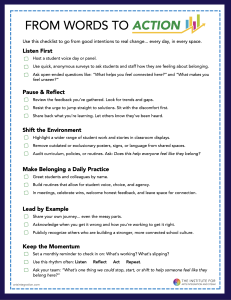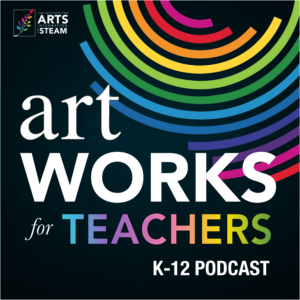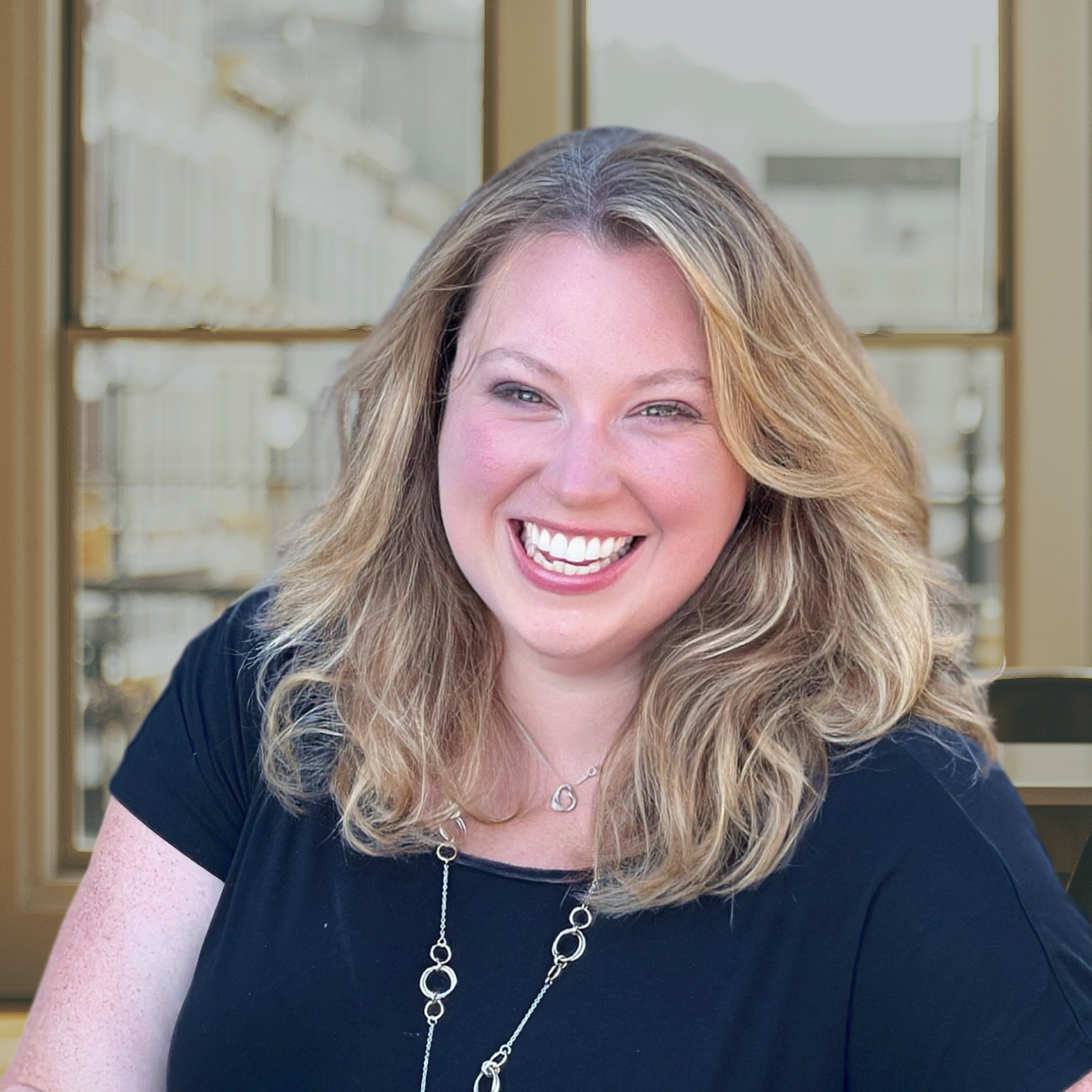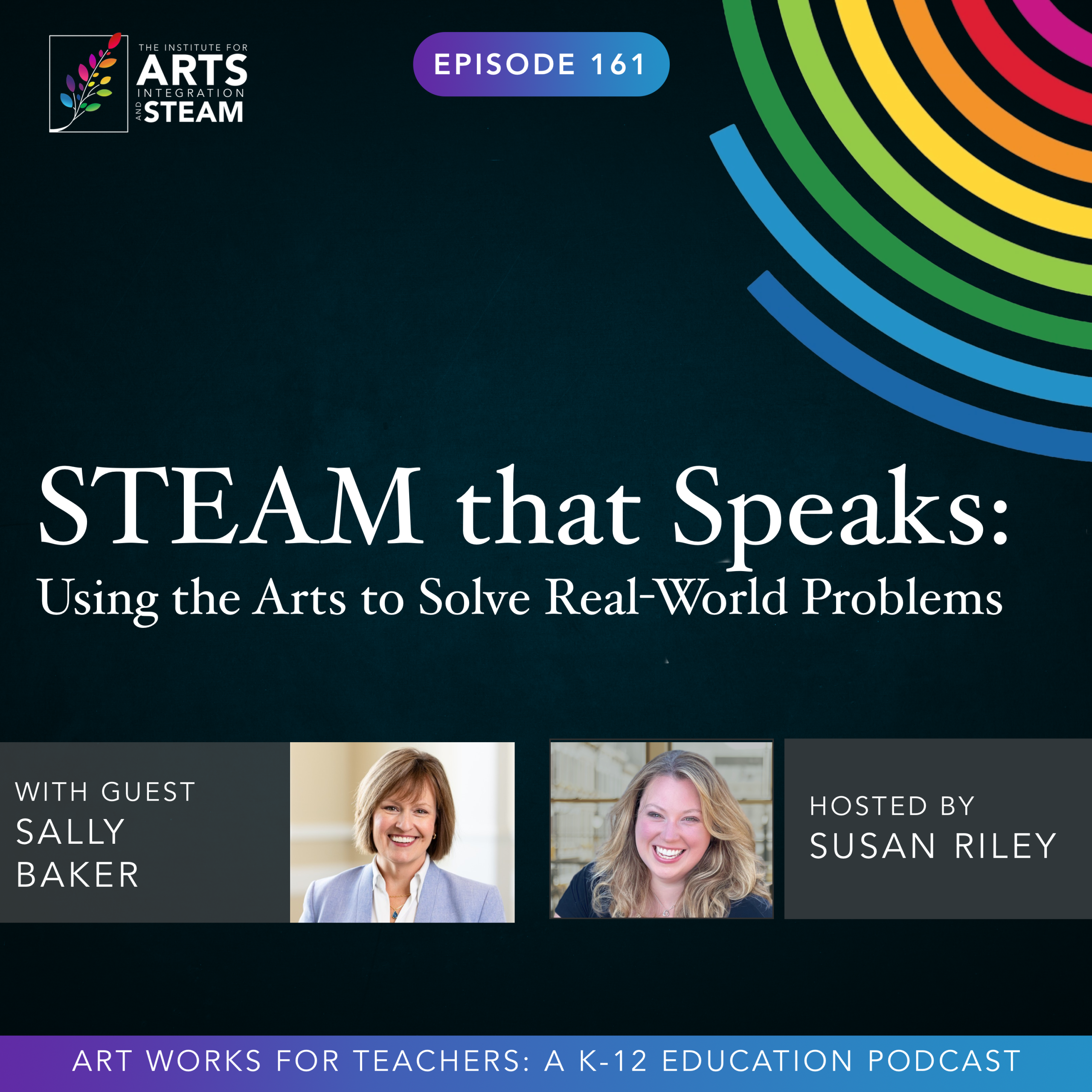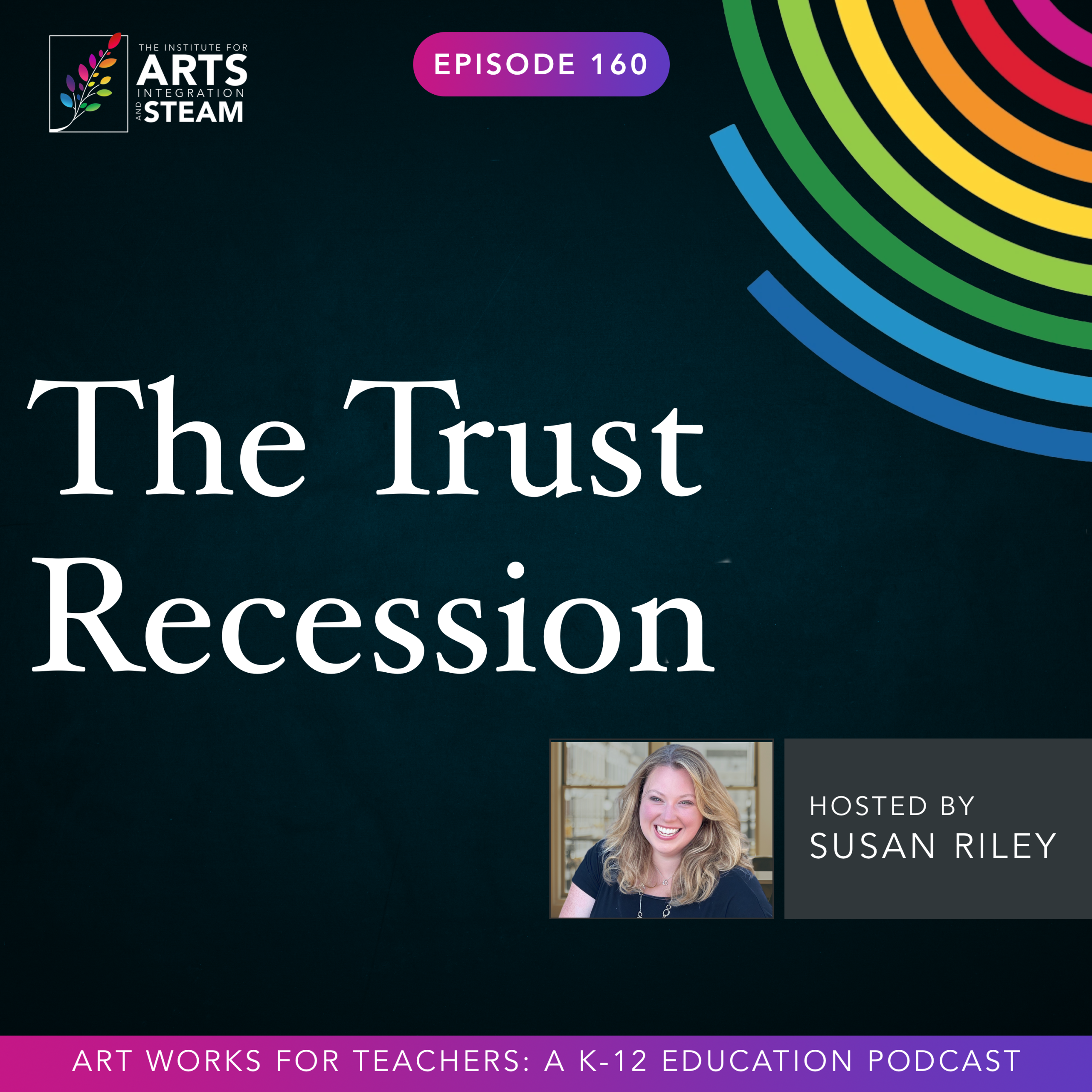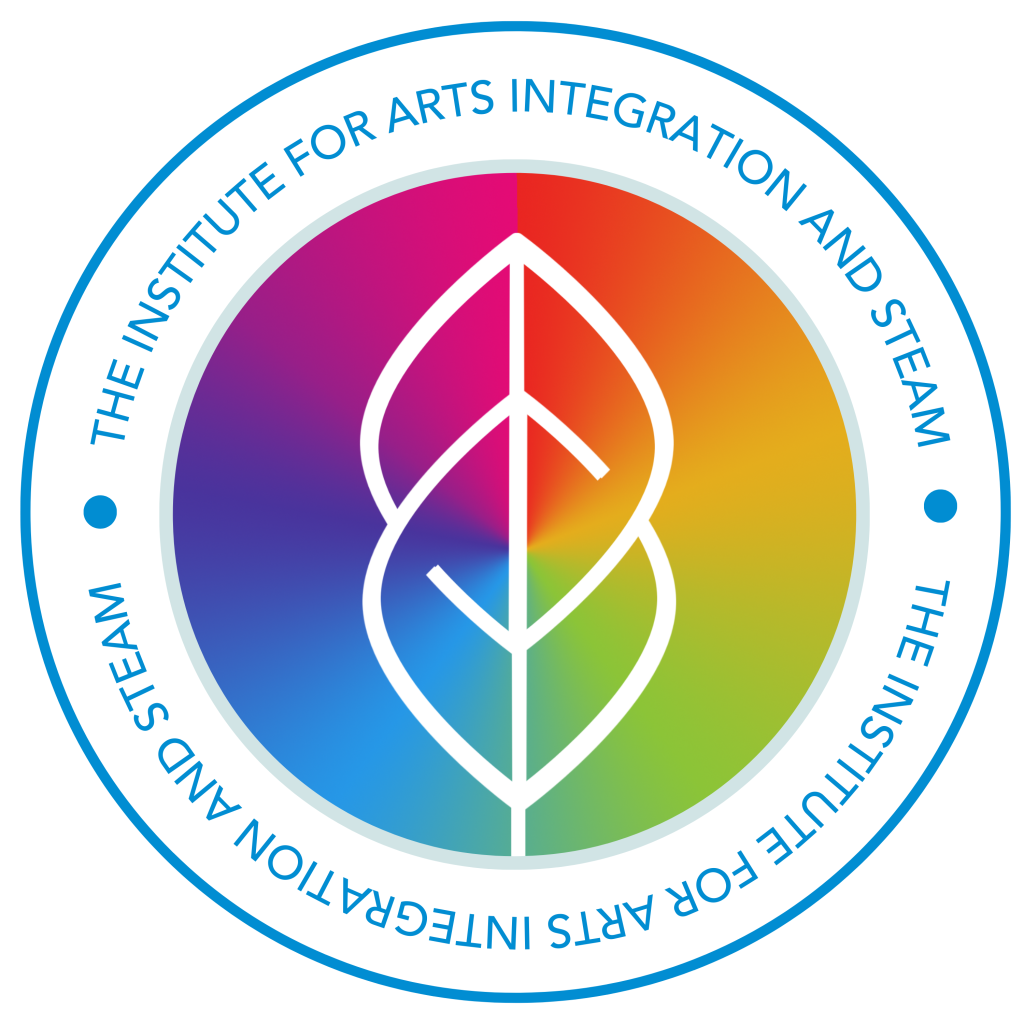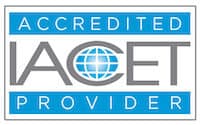ART WORKS FOR TEACHERS PODCAST | EPISODE 132 | 34:33 MIN
Belonging Starts with Listening
What if the key to student belonging isn't a new program, but a shift in how we listen? Dr. Sheldon Eakins shares what too many schools are missing, and how real equity work starts when we stop talking and start truly hearing.
Enjoy this free download of the From Words to Action checklist.
Well, hello, Sheldon. Thank you so much for joining me today. So I always like to start by having our guests just say a little bit about themselves, give us a little bit of your background in education and what got you to this point.
Sheldon
Okay, well, just that's an interesting question because I was just talking to some individuals about kind of like where I've been and I started teaching off in the Virgin Islands and definitely was a great experience for me. I was a history teacher by trade, if you will. So Todd in the Virgin Islands and then I started working on my master's degree in leadership and moved to Florida and taught there.
And then I got a position as a school principal. Man, when was that? Like maybe 2012, 2013, somewhere around there. And so I led a school in Louisiana and then I was invited to work out in Oregon to be a school principal out there. Finished up my PhD, moved into higher ed thinking, oh, I got my PhD. I'm supposed to be a professor or something like that. And but I really realized that I missed the kids so much that I eventually transitioned back to K-12. I started working on a reservation as a director of special education out in Idaho. And then most recently started leading equity within that timeframe. So I'm a educational consultant and I currently live in Phoenix, Arizona where I work with teachers, educators, principals, school leaders, know, what have you, where I support them in their needs, sure and equity at their schools.
Susan
Yeah, and just such a variety of experiences, which I always love, because I think the wider the breadth, the deeper the depth, right? When you get into the classrooms and we're working with teachers and students. So tell me a little bit more about leading equity. I think this is such an important topic right now, especially now, but always. And how you got into this. I think the story around that's really interesting.
Sheldon
Yeah, you know, I so I was living in Idaho and for those who are listening or can't see I'm a black man and you know, black man living in Idaho. I could tell you some stories and honestly, it was just it was just trying to just trying to figure out how to survive out there and maybe survive is not the best word, but just trying to figure out not only how to support myself and like being in a space where it's like I need I need to support and then I had children and working with students of color, for example. And I just hadn't been in this kind of environment. So I decided, you know what? I wanna create content and not just learn how to do things, but I wanted to be able to share it with others. And so I started a podcast. I went to a school principals session out in a conference leadership, one of those kinds of conferences. And I saw these guys doing podcasts and I was like, shoot, didn't look all that hard. And I'm pretty tech savvy.
So I was like, well, I could figure this out. And they sat down and really got to give a shout out to Danny Bauer and then also William Parker. They were there and they're Jethro Jones. These folks have been podcasting before I got there and they sat me down and just kind of went through what I need to do, what kind of equipment I need to get and go through the process. So I started the podcast, that was 2018. And again, not thinking anything of it. was just, again, my opportunity to do some research talk to people like I selflessly found articles on stuff that I was very interested in, like microaggressions and implicit bias and all these different things. So again, so I can support myself and the work that I was doing and I would share it. And not too long, people started reaching out and they say, hey, I listened to your show. I came across your work and love for you to come speak or I love for you to come do a workshop. Can you do some training? And so the next thing I know, I'm full-time consultant. And so that was 2018. So we're coming up on what, six, seven years that I've been doing this work, officially, you know, so I'm very excited for it.
Susan
Yeah, congratulations. Absolutely. you know, I wanted to, I want to ping into this word equity because it's the, it's the thing that's going to get us all banned right now from every federal grant everywhere, right? So, but I think that there is so much misunderstood about the term equity. What does it mean and the difference between equity and culture? So can you give us a little bit of insight from your perspective and all of your experience, can you kind of share with us a little bit, what does equity mean to you and how can we embed more of that within our classrooms?
Sheldon
Yeah, that's a good question. And I'll start off by just giving you a definition equity, just ensuring that each student gets their individual needs met. Just very plain and simple. So that might require some students to, they might need a little bit of extra resources. Sometimes we tend to teach to the general population. So the mainstream kids, but then there's students that are, don't need as much time or there are students that might need a little bit extra time. that's, that's the equity side of things.
The example I like to give is if I was a classroom teacher and I am planning a field trip. I was a history teacher. And so let's say I'm going to the, we're going to the history museum and it's going to cost $10 for every student. Each student is going to pay $10 for this trip. Now in reality of it is yes, everyone pays a $10, which is the equality side of things. However, you might have some families, some students that may need a little bit
You know, they only meet me $2, right? I got eight bucks already. I just need $2 support or I need some help or there's some teacher or some students that might be able to, you know, they may need the whole $10 or try to find help or support or, know, there's maybe some families that can pay for their child and a couple other children. So.
When we're looking at it from an equitable standpoint and we said, okay, what do you need in order to get on the bus, to get on a trip? If you need six bucks, if you need 10 bucks, you need zero bucks, whatever, I can just pay it, whatever that might be. That's the equitable side of things. I think it gets misunderstood a lot because, well, for several reasons, if I had time, I could really unpack it. But I think at the end of the day, you hear something.
Susan
I want you to. I want you to. think it's important. No, seriously, because I think there's this, there is literally this kind of vitriol around equity. And when I have honest conversations around what the difference of equity, equity and equality, people are like, well, I don't understand why this is such a big deal then. So I want you to get into it. What are the misunderstandings? Yeah.
Sheldon
Well, a lot of it is just where it's the misunderstanding. A lot of it comes from the idea that you're taking something away from someone else. So not considering, know what? Historically, there's the way our school system, our school system wasn't built for everyone. Right. So in my book, I talk about the industrial rep, the decolonization. And so after reconstruction, we kind of had the, you know, industrial revolution and those kinds of things happen. And so like a lot of folks were put into quote unquote tracks, like, so they were put into two top down type of ace base content, those kinds of things where like, okay, we're looking at students going into certain fields, but those are white, white, white men. And it wasn't like folks of color, it wasn't women, wasn't those kinds of things. But our schools, the basis of the school system since the industrial revolution has been around, have been the same.
So even when COVID happened, was thinking, okay, now people are starting to realize, wait, there's folks that don't have technology at home. They don't have internet access. I didn't know that was a thing. So like all these things started to come to light and then folks started to see, okay, there are families that don't have what most people assume people have. So I thought it was a really good opportunity for us to kind of revamp what our education system looks like. But then once we started going back to school,
It kind of slowly starts to go back into our regular stuff. So I think again, the misunderstanding is a lot of it's just like, well you're taking resources from people, but no, it's not that we're taking resources from people. We're making sure that each person gets what they need. Those resources that person may not have needed. And that's the piece that we misunderstand when it comes to equality versus equity is everyone gets the same thing, but not everyone needs the same thing from an equality from an equity standpoint. And so just making sure that each person, if the student needs extra support, if they need a little bit extra time, if they need an extra day, if they need special education, if they're disabled, if they need social emotional support, whatever they need, if we can all agree, we want our kids to be successful academically and perform well and be able to do something after high school, whatever that looks like, if we can all agree that that's what we want them to do ultimately, then why don't we give them what they need in order to make that happen? But it gets mixed up and the folks that are doing it often have kids in private school and can afford tutors and all the things. Or they're not educators, so they don't really have that understanding of what that looks like.
Susan
Right, and I think, as you're talking about this, it reminds me of the difference between a scarcity mindset and an abundance mindset, right? Like, we can always bake a bigger pie. You're not taking slices away and you're not gonna have any pie left. It's just bake a bigger pie. And so, if we approach things from more of an abundance mindset, we can kind of see that it's not about taking from. It's about ensuring everyone has what they need, including even gifted and talented students, right? Like the students who need those services sometimes don't get them either because schools can't afford them. So looking across the board, I would love to get your perspective on the difference though between equity and culture because I think these two things sometimes are intertwined and they should be and sometimes they are intertwined and they should not be.
Sheldon
So I would say when it comes between equity and culture, so again, equity is ensuring that each student gets their individual needs met. And then a culture is the environment that students are in. So I'm big on creating a sense of belonging and that would be part of the culture. Like we say, you're welcome here and you're allowed to be who you are and your identities matter to us. we put those things on the walls and we make these, you know, send our handbooks and our emails, bottom our signature, whatever, submission or slogans. But what does that actually look like as are those examples there? Can a student who might identify as Muslim that wears a hijab, can they come to the school and feel as if they're accepted, supported and included within the school culture? Can a student that is from the LGBTQ plus community dress one way that might look appear male or might appear female? Can they be gender fluid? Is that an opportunity where they can, they're still trying to figure things out and they can take the opportunity to kind of learn. Is the school gonna shun them or their peers gonna shun them? Are they going to feel comfortable and brave enough in order to enter into those spaces? That's the culture side of things versus the equity side of things is often just making sure that they have that support that they need. So.
If we're saying, look, you are important to you, to us, you are valued. Are we showing that as opposed to just words on a piece of paper that are on the wall that were, you we just found a nice little AI chat GPT created slogan or quote in that on our wall. But is that action actually there?
Susan
Yeah, so can you give us some examples of what that might look like in a school? Like how would we create cultures of belonging for all of our students so that they can meet their own needs and, you know, reach their potential?
Sheldon
You gotta ask them, first of all, you gotta get feedback. I'm working on a project right now. Sometimes we have student councils, for example. are they doing more than just planning the prom, the school dance, or the Valentine's Day, you know, passing out cards? Or do they actually have input? Do they actually have a say with what they're doing? One of the things that I think is sometimes a touchy subject often is affinity groups, like.
you know, students of color or this group or that group. We're OK with having a chess club. That seems to be fine. We're OK with having robotics clubs. We're OK with having all these different extracurricular activities. But then when we start having, which are fine, right, you have to have an interest in robotics. You have to have an affinity for chess. You have to have an affinity for whatever it is. Cheerleading. OK, those are fine. But then when we say, OK, I have an affinity for black students, have an affinity for LGBTQ, I have affinity for this or that, that seems to be an issue and that seems to be a challenge. And so I try to tell people, and then it's the pushback is often, oh, well, y'all are segregating students. And I say, no, it's not that we're segregating students. You have to keep in mind a student that's 14, 15, maybe 11, 12 years old, that's navigating a space where there aren't people that look like them or can't understand or have the same interests that they have.
Or they're having challenges within their community. They have nowhere to go. Like a lot of families, you know, maybe they have a certain religion and they don't have anywhere to pray. Like these little things that they're trying to navigate in addition to the academic side. We're just talking about social stuff like emotional things. Asking, you know, how do you expect them to do well on the quiz or test? Make sure their homework is turned in when their basic needs aren't being met. I mean, we talk about Maslow and he talks about how the importance of safety.
And if you don't feel safe to be who you are, and I'm not saying physical safety, I'm just saying just feel safe to be who you want to be without feeling forced to assimilate to some other culture, then I think those are little things that we don't necessarily think about. But again, from a large scale where you say, wait, because I'm not, I don't have that identity, I'm not allowed to be able to join or my child can't participate because they don't have this or they don't have that.
That's where things get mixed up. Not considering, know what, your same child where you're complaining, well, they can't be a part of this one group, which affinity groups, as far as I'm concerned, anyone's welcome. But at the same time, you feel like, I'm not welcome because I'm not part of the black community. I'm not part of this community or that community. And, but you're part of the school body in general. And often a lot of stuff that you see caters towards your, you know, probably some of your interests. These individuals don't necessarily see their stuff reflected on a daily basis as you might. So I think those are just some things that we don't always consider.
Susan
Yeah, I think that's so helpful. I wonder in terms of, because I can already hear some people in their response, I can see it in their minds almost popping up, Like, yeah, but what about when, you know, our school tried to do that or has a grant for building these things and that has been taken away now because we've had these buzzwords that have been kind of triggered. So how would you recommend navigating this tricky space that we're in.
Sheldon
Use students, I always say user students. Kids can't get fired. So a lot of times people get, they get worried, right? Cause it's like, okay, I get it. This is wrong. The funding has been taken away and I want to fight and I want to advocate, but I still got to pay my bills. And politically this could be suicide for myself or I could, I could be hurting myself. Maybe I want to become a principal one day or I want to move up in the game. I want to be the department chair. And so I'd need to be quiet because this could help hurt me down the road, I always tell staff or folks that are like wanting to, they see stuff is wrong, but they don't really necessarily, or they don't feel that some folks are like, hey, I'm a paraprofessional. Who am I to, you know, to, to no one's listening to me, you know, these types of things. I said, use your kids, use your students, it's student voice, right? They talk about, you know, I hate the term I hate so much is to, to, to what is it?
What is it? Give, give kids voice, give students voice. No, they have a voice. They can speak. They have a voice. Are you listening to the voice? So maybe we need to shift our language and stop saying, give them voice. No, let them talk. Like give, like listen to them and amplify that. This is opportunity for us. I've had opportunities to be an advisor for various student groups and student councils, for example, all these different things. And, you know, they say,
One the things we do in the beginning of year is like, let's identify two or three things that will make your schooling better, your experience as a student better, okay? We're not gonna just storm the Capitol building, storm the principal's office and to make these demands, how about we say, hey, here's some of the challenges that we're facing and here are some solutions that we've done research on, we've looked into.
We've surveyed the student body. We talked to the kids, our peers about it. These are some things that we feel as a school, as a student body would support us. And that's the stuff that I do with schools. Like we have a school out in Massachusetts area. One of the challenges that they had was they had a large group of Muslim students that did not have a place to pray. They came to the administration and said, hey, we don't have a place to pray. So the administration responded and gave them a place to pray, but the challenge with the place for them to pray was like a beat up, like janitor's closet. it was adjacent to another classroom that was always locked. So they actually literally had to go to the teacher who was teaching in that classroom and they have the knock on the door, interrupt her wherever she's at in teaching and ask them for the key so they can get into the room to go pray. And again, and when you looked at the room and what the room looked like, it's like, this is not a prayer welcoming space. So
We work with the students, work with the students and said, okay, let's come up with some awareness and a solution. So they found a few options, okay? How about maybe the key is left in the main office for the student, if this is the space. Let's definitely make sure we clean up the space so it doesn't look like a generous closet. Let's make it welcoming and inviting. And then let's make sure that the kids have access to the key. We understand that supervision is gonna be a challenge.
So maybe there's some opportunities for maybe a camera or something else to where there's some sort of supervision so that administration feels comfortable with this. But there's some collaboration that needs to take place. Sometimes what happens is we, the students will make these complaints and a principal, mean, I've been a school principal. It's like, you got all these things coming at you. You gotta worry about finance. You gotta worry about academics. You gotta worry about these things.
And now someone else is throwing something at my plate. don't have, how do I create these plans and solutions? And this is something I'm just becoming aware of. So we helped them put a whole PowerPoint presentation. Again, here's the challenges, here's the solutions. These things we think are helpful. And it's not just the four of us or the 10 of us, small group of student council. We represent the student body. We've already submitted surveys and guidance feedback from the rest of the student body.
These are some things that we think are important. The other piece that they wanted to advocate for was lunches. They had students that were vegans or had other dietary restrictions or needed kosher or needed halal. They needed all these different things. And again, school administration best intentions, it's just things that weren't on their radar. So they brought this to the administration, again, in a PowerPoint presentation, professionally, we coached them on how to present. We coached them on how…
We went through it. We ran through it a couple of times. Okay, this is how you're to present it. And these are the solutions that you're going to suggest to the administration. And guess what? You see changes that take place. Administration can definitely appreciate when a student body comes organized. It's not just coming at this administration, your school sucks and blah, blah. And on social media and making pages about like, no, this is like, look, we, we, get it. We get it. You probably didn't know this. Here's some things that we're experiencing. Here's some solutions. Let's work together.
Susan
Yeah, I love this whole idea around advocacy being around pulling data and actually providing solutions. I think, you know, oftentimes advocacy, when you hear the word, you think picket signs and you think, you know, making your voice heard that way. But I think there's such a power in being able to say, understand your perspective to here's some solutions that you could choose from because to your point, so many people either don't realize that they exist or are busy and they would take a solution if it was offered. And so I think it's important for teachers to keep that in mind as well when you're advocating for your students, your classes, the things that you need as well. I think that's an important key to keep in mind. I would love for you to share your story. I've read your story on your website about your opportunity in the Virgin Islands and how you were struck by the cultural differences that you weren't even aware of, because I think this ties in beautifully to this idea of the things that we don't even know that we need to be aware of and can bring to the surface and change a lot of the ways that we teach. Can you share a little bit more of that?
Sheldon
Yeah, absolutely. The thing about it is I am a firm believer of best intentions, right? So again, a lot of things that we do is based off of our lived experiences, how we grew up, our social circles, the individuals that we, know, stuff that we watch on the news, the news station that we choose to watch, the articles that we choose to, you know, these things shape our view of the world. So if you're an educator, I like to assume that we have the best intentions.
Okay, now of course there might be some outliers, but overall I think you like kids and you want the best for your students, right? I think that's something that I generally just assume. So when I went to the Virgin Islands and I grew up in Houston, Texas, that's what I call home. I have what, you I grew up learning the music I like to listen to, the customs, the practices and all those things. So I go overseas.
First teaching job, so I'm already fresh out of college teacher prep class, right? Fresh out of that, never had a classroom outside of my student teaching. So this is, everything's new. And I'm in a land, an area, an island that I just had, I'd never been to an island before. It's just, everything's new. So, however, I was very confident. I'm a confident guy, right? And so I start school and I'm high-fiving the kids and having a great time.
And my roommate at the time, he was born and bred in the Virgin Islands. He's from St. Croix. He's Cruxian to the core. And he pulls me to the side and he says, Sheldon, everybody hates you. I'm like, wait, what just happened? Because like I said, I'm high fiving kids and I'm I'm getting to know, like, I'm enjoying myself. I'm on the island, right? Island life. And he's like, no, like.
They say you're so rude to them. And I didn't understand. I'm like, what happened? He's like, when someone says good morning to you, like you walk into school and someone says good morning to you, what do you say back? I'm like, I'm from Texas. I'm like, what's up? How's it going? What'd it do? Like, how you feeling? He said, that's rude. He said, in our practice, according to our customs, our culture, if someone says good morning to you, you say good morning back someone says good afternoon, good evening, whatever time of day it is, you say that back to them. You don't say what's up. You don't say how you feeling. You respond the same way. If you walk in, this is something I had to learn. Cause I, again, I didn't know I was being rude. had no clue. Like I just being myself had no idea. No one told me this. I walk into it. You, you ever have to go to the post office and deliver packages. Now you walk into it, you know, stand in line. You're supposed to say good afternoon or whatever it is, whatever time it like.
We don't do that in the States. I've never done this before. If I go to the mail a package, I'm in a hurry. I'm frustrated. I'm annoyed that I have to be in line. Like I walk in there. But no, it's like, no, wherever, whenever you walk into a building, whenever you walk into space, whether you know the people or not, you address it. And I started to pay attention to that because I noticed like people would say, you know, walk into the store or whatever. And people say, good morning. I noticed that, but it didn't necessarily registered, I wouldn't respond. wouldn't say nothing back. just like, who was it? I don't know you, right? I don't know who you are. And so he taught me this lesson. And again, unintentionally, I was being rude because I was not familiar with the cultural practices that I was involved in. I could blend in all day until I start talking. Like then they're like, wait, wait, you're not from here. But as far as long as I didn't say anything, I was good. So I was used to kind of just like skating by, if you will, just blending in because half the time I couldn't understand what people were saying anyway. So I took that very seriously. And I said, okay, I'm in someone's space. I am a guest in this community that I am serving. Yes, I want my students to do well and I'm having a great time in the classroom, but the social side of things and the cultural aspects of things, I am totally missing. So that was a moment for me to start participating in all the, I went to all the festivals. I went to, I started learning about the music I had teach students teaching me what reggae is, the difference between reggae, Calypso and Soca music. Cause I thought it was just all Caribbean music, but there's different, there's different, like one of my students, I love him to death. His name was Jason. He said, okay, Sheldon, if you hear a heavy bass line, that's often like a reggae tone, right? If you hear something that's really fast and a lot of drum, drum heavy, that's probably going to be Soca music. So like he started like breaking all the stuff down to me. I started learning a lot of slang, because we speak English, like a lot of stuff meant stuff differently and they utilize a lot of different terms differently. So I didn't know I was being culturally, I started to become culturally responsible. I didn't know that was a thing. hadn't really like, yeah, I went through teacher. I've learned so many frameworks and theoretical stuff, but that was my first experience really getting immersed into cultural responsiveness, which I took to a lot of places. Like I said, I worked on a reservation. Had I gone to all the reservation again, with just being me and you know, this, no, I started asking questions. Tell me about the festival. I got invited to powwows. I got invited to sun festivals and ceremonies and all these different things and learn about round dancing and all like staging and all smudging, all this different stuff because I started to become more open to the community that I'm serving. It's not just me trying to pay it, earn a paycheck. It's not just me trying to, you know, be the cool guy, but it was just more of me recognize and I am a guest in someone else's space and I need to act accordingly.
Susan
Yeah, and it reminds me so much of the power of being curious, right? I think curiosity helps us in so many ways if we approach things from that standpoint. Sheldon, thank you so much for joining us today. This has been so enlightening for me and I've learned a lot from you. Can you share where our audience can stay in touch and find out more information about you?
Sheldon
Yeah, absolutely. My current book out is Leading Equity Becoming an Advocate for All Students. That's off of Josie Bass out of 2022. I actually have two more books coming out this year. One is called The Culture Clash, and that one's on for teachers and instructional practices and cultural responsiveness. And then I have another book called What Are You Bringing to the Potluck? And that's all about creating a sense of belonging. But all my work can be found on leadingequitycenter.com and then also I have a podcast as well. It's called leading equity. So you type that in, you'll find.
Susan
Fantastic, and we will include all of that in the show notes so that people can find you. Thank you again so much. This has been wonderful.
Sheldon
Yeah, my pleasure, thanks.

